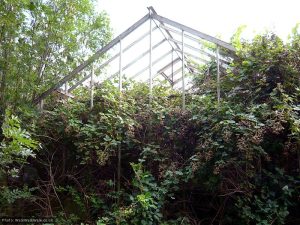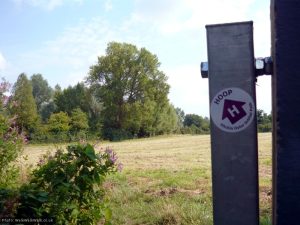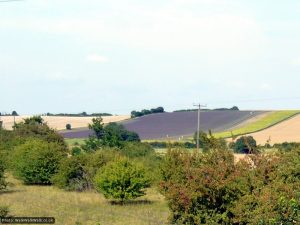The start of this section is one of those areas where the HOOP decides to display to the walker the wildly contrasting nature of its route. Emerging from the shaded, reedy wilderness of the nature reserve, and passing the idyllic-seeming buildings of the mill, the walker approaches then crosses a tarmac lane that provides one of the major parking spots for the popular Oughtonhead Common area.

It was as busy as ever when we passed through with plenty of people taking advantage of suddenly sunny weather to walk, cycle or exercise their dogs. The whole nature reserve had been a sociable experience and now we would be returning to the solitude of footpaths through agricultural land before approaching the village of Ickleford which lies just to the north of the town.
The footpath ahead was all but blocked by parked cars but we managed to just about squeeze through to get access to a stile. We found ourselves immediately back on a bleak section of field-edge paths overlooking vast prairie-like expanses of crops – wheat pretty much ready for harvesting at the time we passed through. This set the scene until the time came to cross the busy Bedford Road.
The crossing is well-managed for pedestrian safety, also passing the local headquarters of Hertfordshire’s Countryside Management Service, one of the organisations that has been instrumental in setting up the path. Convenient for them if they should want to take a stroll around the town…

The path cuts sharply up the side of The Old Dairy buildings to enter a green tunnel flanked to the right by semi-abandoned horticultural buildings and brambles. Tantalisingly, hanging well out of reach behind a secure fence, were some of the best blackberries of the day.
Pleased to get some shade after the exposed walk across from Oughtonhead Common, we followed a path which cuts between fields and houses to skirt the north of the village, one of the day’s prime blackberrying spots. As we walked and picked fruit we became increasingly curious as to what might lie ahead thanks to a series of intermittent shouts and cheers issuing through the bushes. To our delight we realised that a village cricket match was in progress and we paused at the recreation ground to watch.
Sitting on a bench, we watched several overs, putting our feet up for a bit to enjoy a snack and a drink. This was one of the day’s highlights and a very pleasant interlude – one also enjoyed by several other groups of passing walkers. But, as pleasant and compelling a pastime as watching cricket may be, especially when the sides playing can clearly muster some competent bowling and the contest between bat and ball is well-balanced, we needed to get on with the job in hand.
Reluctantly we rose, walked past the Plume of Feathers pub, and cut through the village centre before picking up another very familiar path that would take us alongside the railway and eventually connect up with the Burymead Springs nature reserve (not on our itinerary today but a nevertheless unusual wetland habitat for North Hertfordshire that repays a visit). Ickleford is a charming village and, if you are unfamiliar with it, well worth factoring in time to explore – especially the village green and the historic area around the church.

Picking up the HOOP route again on the far side of the road we found the River Hiz (historically pronounced “Hitch”, thus giving Hitchin its name) in a parlous state. The nasty smell and the cloudy water indicated that it had been subject to a sewage spill or overflow, the warm day helping the situation not at all. Nodding as usual to Gerry as we passed his final resting place, in the hope of propitiating his ghost, we fled from the smell and continued our walk as quickly as we could. Whoever was responsible may well have felt the sharp edge of the ghostly former navvy’s wrath, however.
As you might gather from the above, this little patch of North Hertfordshire is dominated by railways and railway heritage. In addition to the former trackbed of the Bedford to Hitchin railway the East Coast Mainline is, of course, alive and well and robustly in use. Ickleford has one of those ruler-straight track sections of the sort that have led to this line being involved in various land speed records down the years.
Crossing the tracks on the giant footbridge is always fun and we must admit to waiting for some trains to appear. We were rewarded with a Kings Cross to Peterborough commuter service shortly followed by a speeding express on its way to London from Edinburgh. Descent on the eastern side and then, to our surprise, one of the toughest sections of the day. Between Ickleford and Wilbury the route runs on the Icknield Way long-distance path. The rolling scenery that looks so attractive from a distance and the paths that seem so beguiling when strolled along casually were, frankly, a slog.
By now, on a day that had started out misty and overcast, the sun was beating down and the water bottle was down to the dregs. Having seen the purple field of Hitchin Lavender (also known as Cadwell Farm) in the distance, and also prominently featured in the path’s promotional literature, it was perhaps a little surprising not to visit it directly as part of the walk – but we did spot a signed footpath that would have taken us there following a short detour.

Lavender is, of course, a traditional crop for the area and if you’re not local (or even if you are and have never seen the field close up) it is pretty much a must-visit – the fields look and smell breathtaking when in flower. Problem is, as hardened long-distance walkers know, if you’re on a 14-mile walk you’re often reluctant to take the slightest detour, even if it’s only one or two hundred yards.
After pressing on from the farm towards the Stotfold Road crossing we were sweaty, tired and keen for a rest when we spotted the trees and bushes marking the edge of Wilbury Hill Camp, the Wilbury Hotel and its adjacent car park.